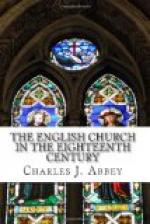J.H.O.
FOOTNOTES:
[Footnote 431: [Greek: autotheos].]
[Footnote 432: [Greek: phos ek photos].]
[Footnote 433: See Van Mildert’s Life of Waterland, Sec. 3, p. 29.]
[Footnote 434: Id.]
[Footnote 435: ’We cannot charge anything to be a contradiction in one nature because it is so in another, unless we understand both natures. Because a nature we understand not, cannot be explained to us but by allusion to some nature we do understand.’—Leslie’s Theological Works, vol. ii. p. 402, ‘The Socinian Controversy.’]
[Footnote 436: Leslie’s Theological Works, ii. 405.]
[Footnote 437: By his famous ‘a priori’ arguments for the Being and Attributes of God, and by his answers to the Deists generally.]
[Footnote 438: Potter also, subsequently Archbishop of Canterbury, entered into the lists against Clarke.]
[Footnote 439: Dr. Whitby (already favourably known in the theological world by his commentary on the Bible), Mr. Sykes, and Mr. Jackson, Vicar of Rossington and afterwards of Doncaster, &c.]
[Footnote 440: He proceeds to explain S. Matthew, xxiv. 36, S. Luke, ii. 52, and S. John, v. 19, in a sense consistent with the Catholic doctrine.]
[Footnote 441: See vols. i. ii. and iii. passim of Waterland’s Works, edited by Van Mildert.]
[Footnote 442: Toulmin’s Memoirs of Faustus Socinus, p. 191.]
[Footnote 443: Toulmin’s Memoirs of Faustus Socinus, p. 180.]
[Footnote 444: Id. 211.]
[Footnote 445: Id. p. 467.]
[Footnote 446: Toulmin, p. 281. See also on this point Thomas Scott’s interesting account of his own religious opinions in the Force of Truth, and in his biography by his son.]
[Footnote 447: ‘The Christian Doctrine of the Trinity,’ by Isaac Watts, vol. vi. of Works, p. 155.]
[Footnote 448: ‘The Christian Doctrine of the Trinity,’ by Isaac Watts, vol. vii. of Works, p. 196.]
[Footnote 449: Watts, p. 200.]
[Footnote 450: ’The Arian Invited to an Orthodox Faith.’—Works, vol. vi. p. 348.]
[Footnote 451: Id. 225.]




